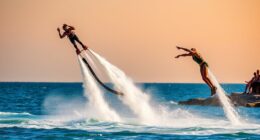To learn to sail effectively, you need to grasp the fundamentals of wind, sails, and hulls. Wind propels your boat, so understanding its direction and strength is vital. Sails catch this wind, and adjusting them as effectively as possible will enhance your boat’s balance and speed. Hulls provide stability and maneuverability. As you practice and gain experience, you’ll deepen your knowledge and skills. Stick with it, and you’ll uncover more significant insights for your sailing journey.
Key Takeaways
- Wind is the primary propulsion force; learning to read its direction and strength is essential for effective sailing.
- Sails catch wind and are crucial for forward motion; understanding their specific roles enhances boat operation.
- Proper sail trimming is vital for maintaining balance and speed, adapting to varying wind conditions improves performance.
- Familiarize yourself with safety protocols and gear, including pre-sailing checks and emergency procedures, for a safer experience.
- Continuous practice and learning from experienced sailors deepen your understanding of wind, sails, and hulls, enhancing your sailing skills.

Have you ever dreamed of gliding across the water with the wind in your hair? Sailing offers that exhilarating experience, and it’s a skill worth mastering. To get started, you’ll need to familiarize yourself with the essential elements of sailing: wind, sails, and hulls. Understanding these components will help you harness the wind and navigate effectively.
Sailing is an exhilarating skill that lets you harness the wind and glide across the water.
First off, let’s talk about wind. It’s your primary source of propulsion, and knowing how to read it is *vital*. Pay attention to the direction and strength of the wind, as this will determine how you set your sails. You’ll want to practice using basic navigation techniques, like understanding wind angles and points of sail, to maximize your boat’s efficiency. For instance, when the wind blows directly behind you, you’re sailing downwind. In contrast, when the wind comes from the side, you can reach or beat toward your destination. The more you learn about the wind, the better your sailing experience will be.
Next up are the sails. They’re your means of catching the wind and converting it into forward motion. Each sail has a specific role, and knowing how to trim your sails correctly will keep your boat balanced and fast. You’ll need to experiment with different sail configurations to see how they respond to varying wind conditions. Remember, it’s not just about hoisting the sails; it’s about adjusting them to optimize performance.
Now, let’s not forget about safety protocols. Sailing can be thrilling, but it also involves risks. Before you set out, *make sure* you’ve checked your gear, including life jackets, flares, and a first aid kit. It’s essential to have a safety plan in place. *Make sure* you know how to operate your boat and what to do in case of emergencies. Always keep an eye out for other vessels and be aware of your surroundings. Knowing the rules of the water will not only keep you safe but also make your sailing experience more enjoyable. Additionally, just like caring for fine rugs, maintaining your sailing gear is crucial for long-term performance and safety.
As you progress in your sailing journey, you’ll find that practice makes perfect. Embrace learning from each outing, and don’t hesitate to ask for advice from experienced sailors. They can teach you invaluable skills and insights that will enhance your understanding of wind, sails, and hulls. Remember, sailing is as much about the journey as it is about the destination. So, get out there, feel the wind, and enjoy every moment on the water!
Frequently Asked Questions
What Are the Best Types of Boats for Beginners?
The best types of boats for beginners are typically small, stable vessels like dinghies or daysailers. These boats have simple boat construction, making them easier to handle. You’ll find that their lightweight design helps you learn essential sailing techniques, like tacking and jibing, without overwhelming you. Plus, they’re often equipped with basic controls, allowing you to focus on mastering the skills you need to enjoy sailing safely and confidently.
How Much Does Sailing Equipment Typically Cost?
Sailing equipment can feel like a treasure chest waiting to be opened. Typically, you’re looking at costs ranging from a few hundred to several thousand dollars, depending on quality. For budget sailing gear, you can find decent options that won’t break the bank, often starting around $200. Just remember, investing in reliable gear is key; it’ll keep your adventures smooth and safe on the water. So, chart your course wisely!
Can I Learn to Sail Without Formal Lessons?
Yes, you can learn to sail without formal lessons. With self-study resources like books and online tutorials, you can grasp the basics at your own pace. Start by watching instructional videos that cover sailing techniques and terminology. Join sailing forums to connect with experienced sailors who can share tips. While hands-on experience is essential, these resources will give you a solid foundation to build your sailing skills. Enjoy the journey!
What Safety Gear Should I Have on Board?
You should always have life jackets and emergency flares on board. Each person on your boat needs a properly fitted life jacket, ready for quick access. Emergency flares are vital for signaling help in case of an emergency. Additionally, consider having a first aid kit, a fire extinguisher, and a whistle. It’s important to check your gear regularly to make sure everything’s in working order, so you’re prepared for any situation on the water.
How Do Weather Conditions Affect Sailing Plans?
Weather conditions considerably impact your sailing plans. You should always check weather patterns before heading out, as they can change rapidly. Seasonal variations affect wind strength and direction, which can determine your route and safety. In summer, you might encounter calmer seas, while winter can bring fierce storms. By staying informed about the forecast, you can make smarter decisions and guarantee a safer, more enjoyable sailing experience. Always prioritize your safety on the water!
Conclusion
As you set out on your sailing journey, remember that mastering the dance between wind, sails, and hulls is just the beginning. Embrace the gentle whispers of the breeze and the playful nudges of the waves. Each outing brings new lessons wrapped in adventure, guiding you closer to becoming a seasoned mariner. So, hoist your sails with confidence, and let the sea’s embrace lead you to horizons yet unseen. Happy sailing—you’re in for a delightful ride!










